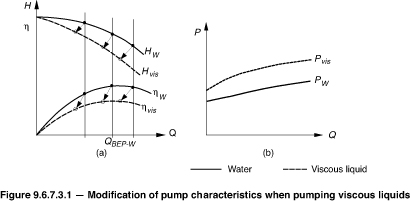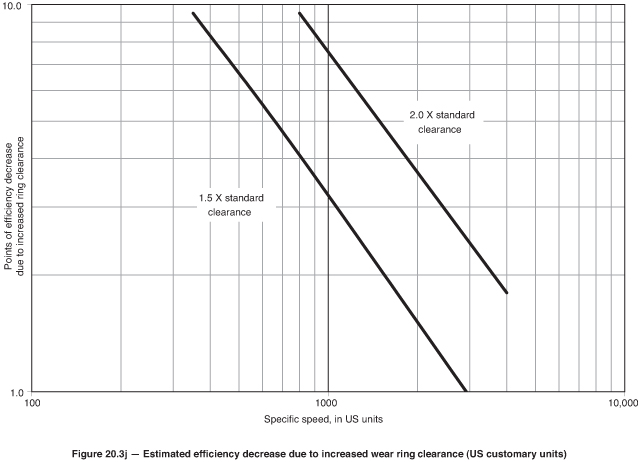Q. When pumping a liquid that has a viscosity greater than water, how can the effect of this higher viscosity on the pump performance be estimated?
A. The Hydraulic Institute (HI) has developed a generalized method for predicting the performance of rotodynamic pumps on Newtonian liquids of viscosity greater than water. This is an empirical method based on the test data available from sources throughout the world. The HI method enables pump users and designers to estimate the performance of a particular rotodynamic pump on liquids of known viscosity, given the performance on water. The procedure may also result in suitable pump selection for a required duty on viscous liquids.
Performance estimates using the HI method are only approximate. The method does not take into account many factors of particular pump geometries and flow conditions. It is nevertheless a dependable approximation when only limited data on the pump are available, and an estimate is needed.
The performance (head, flow, efficiency and power) of a rotodynamic pump is obtained from the pump's characteristic curves, which are generated from test data using water. When a more viscous liquid is pumped, the performance of the pump is reduced. Absorbed power will increase and head, rate of flow, and efficiency will decrease.
When a liquid of high viscosity, such as heavy oil, is pumped by a rotodynamic pump, the performance is changed in comparison to performance with water, due to increased losses. The reduction in performance on viscous liquids may be estimated by applying correction factors for head, rate of flow, and efficiency to the performance with water.
Thus the curves of head and efficiency for viscous liquids (subscript vis) are estimated from the head, flow, and efficiency measured with water (subscript W) by applying the correction factors CH, CQ, and C?, respectively. These factors are defined in Equation 1.

Equation 1
Figure 9.6.7.3.1 (a) and (b) show schematically how the head, efficiency and power characteristics typically change from operation with water to pumping a highly viscous liquid.

The HI method explained in Section 9.6.7.4 of ANSI/HI 9.6.7 Effects of liquid Viscosity on Rotodynamic Pump Performance, is based on empirical data. It provides a way to predict the effects of liquid viscosity on pump performance with adequate accuracy for most practical purposes.
Q. What is the typical procedure for conducting a hermetic integrity test on sealless pumps?
A. Hermetic integrity tests shall be conducted on completely assembled pump units. Disassembly after the test is not permitted. The primary and secondary (if so equipped) containment boundaries shall be tested separately.
Test duration—Test pressure shall be maintained for a sufficient period of time to permit a complete examination of the parts under pressure. A minimum of three minutes is considered necessary for this examination, unless acceptance criteria “c” is required.
Test fluid—The test fluid shall be air or an inert dry gas. Where specified, there shall be no water or other liquid present in the test fluid.
Test pressure—Because a compressible fluid is being used and the test is not conducted in an isolated safety chamber, the test pressure shall not exceed 75 percent of the maximum working pressure or 517 kPa (75 psig) with a minimum working pressure of 69 kPa (10 psig), whichever is lower.
Test temperature—Tests shall be conducted at room temperature.
This test is not conducted at or above maximum working pressure. For this reason, this test does not give verification that a leak shall not occur at maximum working pressure.
During the test, gas shall be introduced into the primary and secondary containment boundaries. Each area shall be tested separately. The primary boundary shall be pressurized first. Once the primary boundary has been proven, the secondary boundary shall be pressurized. (Note: If pressurizing the secondary boundary could damage the primary boundary, then it is permissible to pressurize the primary boundary during the test of the secondary boundary.)
After the pressure has stabilized, one of three methods can be used to determine leakage:
a) Inert gas sniffer test
b) Pressure drop observation, after pressurization but before starting the test, isolate the item under test from the pressure source and then disconnect the pressure source
c) External soap bubble test
One of the following acceptance criteria shall be used, depending on the test method selected from the list above. For example, acceptance criteria “a” shall be used for test method “a.”
a) A leakage of no more than 1x10–4 mL/s (6x10–6 in3/s) of gas shall be observed.
b) A pressure drop of no more than 0.4 kPa (0.06 psi) shall be observed for a period of not less than 10 minutes or a measured pressure drop rate of not more than 7x10–4 kPa/s (1x10–4 psi/s). The acceptance criteria assume that no significant temperature change occurs during the test.
c) No observable leakage shall occur for a minimum of 10 minutes.
Additional information pertaining to testing is available in ANSI/HI 5.1-5.6, Sealless Rotodynamic Pumps for Nomenclature, Definitions, Application, Operation, and Test.
Q. When maintaining centrifugal pumps, how important is renewing the impeller wearing ring clearance?
A. Wear ring clearance can be very important if efficiency of operation is important. HI has published a new standard, HI 20.3 Rotodynamic (Centrifugal and Vertical) Pump Efficiency Prediction, which provides more detail. Figure 20.3j from that standard shows how much 1.5 and 2.0 times the standard clearance reduces the pump efficiency.

Other factors that influence efficiency are:
- Type of pump
- Surface roughness
- Internal clearances
- Mechanical losses
- Liquid pumped properties
- Special impeller designs
- Impeller diameter trim
- Thrust balance method
More details regarding these factors can be found in HI 20.3.

